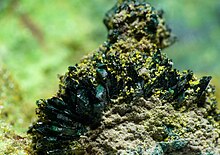|
Vandenbrandeite
Vandenbrandeite is a mineral named after a belgian geologist, Pierre Van den Brande, who discovered an ore deposit. It was named in 1932, and has been a valid mineral ever since then.[2] PropertiesVandenbrandeite grows in microcrystals, up to half a millimeter. It may be rounded, lathlike. The crystals are flattened on {001}. It grows in parallel aggregates, in a lamellar, scaly shape.[3] It is tabular, meaning its dimensions in one direction are weak.[4] It is a pleochroic mineral. Depending on the axis the mineral is seen the color of it changes, which is an optical phenomenon. On the x axis it can be seen as a blue-green, and on the z axis is seen as a yellow-green mineral. It is highly stable in the presence of both water and hydrogen peroxide.[2] Vandenbrandeite, due to being strongly radioactive, is usually closely associated with other radioactive minerals.[5] Its radioactive properties is due to its composition. The mineral is made out of 59.27% uranium, which is the main component of the mineral. It has a GRapi (Gamma Ray American Petroleum Institute Units) of 4,352,567.33. It has a concentration of 229.75 measured in GRapi. Other chemical elements included in vandenbrandeite are oxygen (23.9%), copper (15.82%) and hydrogen (1%). Although it is radioactive, the mineral is not fluorescent. It is a secondary mineral. [4] References
|
||||||||||||||||||||||||||||||||||||||||||||||||||||||||||||||
